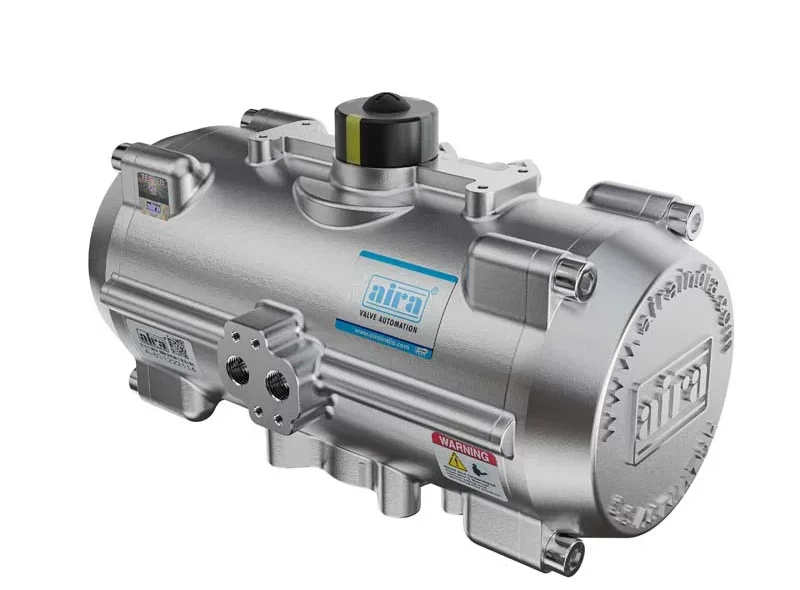In the modern industrial landscape, valve automation is a crucial aspect of ensuring efficient and reliable operations in various sectors, including oil and gas, water treatment, pharmaceuticals, and manufacturing. One of the most essential components in valve automation is the pneumatic actuator, particularly the pneumatic rotary actuator, which plays a vital role in automating valve control systems.
What is a Pneumatic Rotary Actuator?
A pneumatic rotary actuator is a mechanical device that converts compressed air into rotational motion, allowing valves to open and close efficiently. These actuators are commonly used in quarter-turn valves, such as ball valves and butterfly valves, as well as dampers and other rotating components in industrial applications.
Pneumatic rotary actuators are preferred in many industries due to their reliability, quick response time, and ability to operate in hazardous environments where electrical actuators may pose risks.
Working Principle of Pneumatic Rotary Actuators
The working mechanism of a pneumatic actuator involves the use of compressed air to generate rotary motion. Here’s how it typically functions:
Air Supply
– Compressed air is supplied to the actuator, which creates pressure inside the actuator chamber.
Piston Movement
– The air pressure pushes pistons inside the actuator, causing rotational movement.
Torque Generation
– The force exerted by the pistons is transferred to the output shaft, generating the necessary torque to operate the valve.
Return Mechanism
– In spring-return actuators, the spring resets the actuator when the air supply is cut off, while in double-acting actuators, air pressure controls both opening and closing movements.
Advantages of Pneumatic Rotary Actuators in Valve Automation
Pneumatic rotary actuators offer numerous benefits in valve automation, making them a preferred choice in industrial applications.
1. Fast and Efficient Operation
Pneumatic actuators provide quick response times, allowing valves to open and close rapidly. This feature is particularly useful in applications that require precise and timely control of fluid or gas flow.
2. Durability and Reliability
These actuators are designed to withstand harsh conditions, including extreme temperatures, corrosive environments, and heavy-duty industrial applications. Their simple mechanical design reduces the chances of failure, ensuring long-term reliability.
3. Cost-Effective Solution
Compared to electric and hydraulic actuators, pneumatic actuators are more cost-effective due to their lower initial cost and minimal maintenance requirements. They also have a long operational lifespan, reducing overall expenses.
4. Safe for Hazardous Environments
Industries dealing with flammable or explosive materials prefer pneumatic rotary actuators because they do not generate sparks, reducing the risk of accidents. Their air-powered mechanism makes them ideal for chemical plants, oil refineries, and gas processing units.
5. Low Maintenance Requirements
With fewer moving parts and no complex electrical components, pneumatic rotary actuators require minimal maintenance. Regular inspection and proper lubrication ensure smooth operation and long service life.
Applications of Pneumatic Rotary Actuators in Valve Automation
Pneumatic rotary actuators are widely used in various industries for automating valve operations. Some common applications include:
Oil & Gas Industry
– Used in pipeline control valves to regulate the flow of oil and gas.
Water Treatment Plants
– Helps in controlling the flow of water and wastewater through pipelines.
Chemical Processing
– Ensures safe and efficient operation of valves in chemical processing plants.
Pharmaceutical Industry
– Used for precise fluid control in the production of medicines and chemicals.
Power Plants
– Assists in steam and gas flow control for efficient energy generation.
Types of Pneumatic Rotary Actuators
There are two main types of pneumatic rotary actuators used in valve automation:
1. Rack and Pinion Actuators
This type of actuator consists of a rack-and-pinion mechanism, where the linear motion of pistons is converted into rotary motion. These actuators are compact, cost-effective, and suitable for small- to medium-sized valves.
2. Scotch-Yoke Actuators
Scotch-yoke actuators use a yoke mechanism to generate torque, making them ideal for high-torque applications. They are commonly used in large industrial valves requiring high force to operate.
Conclusion
The pneumatic actuator is an indispensable component in modern valve automation, ensuring efficient, reliable, and cost-effective operation in various industries. Whether used in the oil and gas sector, water treatment facilities, or chemical processing plants, pneumatic rotary actuator play a crucial role in maintaining smooth and safe industrial processes.
With their robust design, fast response time, and ability to function in hazardous environments, pneumatic rotary actuators continue to be the preferred choice for industries looking to automate their valve systems effectively.












